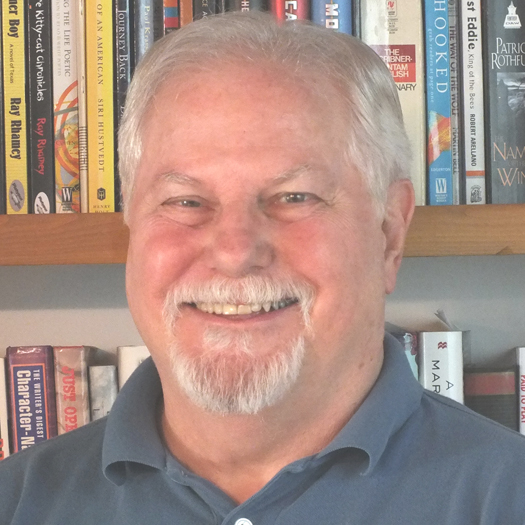The Fun of Pantsing
By Ray Rhamey | December 3, 2019 |

I had a vampire tale going, and much of the story revolved around a murder. Actually, four murders. I had written a mystery before that seemed to work, and I had pantsed that one, too. You know, make it up as you go along. No outline. No plotting far ahead. For me, part of the fun of pantsing comes from the process.
Process? What process? I thought you said you were a pantser.
Well, something happens, and I’m gonna call it my process. It starts with an idea, of course, and this one began with the notion of murdering vampires. Since they are “the undead,” how do you do that? Well, I wanted to find out. And I decided to call them unmurders.
You heard that right. I was writing an unmurder mystery.
Before beginning the actual storytelling, my, ahem, process involves amassing pages and pages of single-spaced notes of scenes, of things that need to happen, the nature of my protagonists, the antagonistic characters, the jeopardy and peril I’ll cause for my characters, the ending, etc. For this book, the amassing part of the process stretched over a year as I had lots of editing and book-design work going on at the same time–but I was finally free to write.
When I knew what needed to happen, the next part of the pantsing process was to write the scenes in order to learn how they happened. Away I went . . .
But then came an uh-oh moment.
Not enough gas in the tank.
Welp, I was at about 35,000 words and the number and nature of the future events that I had imagined (not outlined, just listed as future events) felt a little on the lean side. I did a quick investigation of how many words went into each of the major scenes that had already been written, applied an average word count to the events that were to come, and it sure looked like I would run out of story before I had a novel, word-count wise.
What to do? I was having too much fun with the story to abandon it. It was time to kick my pantser muse back into action.
For me, this is another time when pantsing is fun because it’s, well, creative. I needed to add length to the story with a logical, meaningful way to extend it, not pad existing scenes. And to increase the pressure on my characters with more and more going wrong.
So what I did was . . .
That word-count shortcoming led to more of the fun part—research. Thanks to the instant nature of the internet, I was soon able to find out the law on certain crimes dealing with corpses and about legal procedures in California, where this story takes place. Quickly I had the mechanisms in mind and I could go ahead and cause trouble for my characters with authenticity. In this case, since I was dealing with the undead, the legal definition of what constitutes “death” mattered, a lot. It turned out there are two distinctively different definitions of death in California, and that fit right in with my story complications and promised a fun trial scene.
Soon I was back at the keyboard and, happily, in a few days my research had delivered the solution. All that had come before could pretty much stay as it was with little rewriting needed. By adding the new twist and the ripples of complication it generated, the WIP was 10,000 words richer, and the story turned out just fine, length-wise, thanks to that addition.
How about you? Are you a pantser? Plotter? Combo? What’s your process?
Happy writing.
Ray
[coffee]










Ray: nice save about the two definitions of death. The wonders of internet research!
My process: combo. Too much plotting and the story lies dead on the page, with no hope of resuscitation. Too much pantsing and the whole thing sprawls and flops. Compromise (usually effective): alternate, or bounce between.
Question or appeal: Oh, no—don’t unmurder Patch!
Patch remains the star of my vampire kitty-cat chronicles. I’m currently rewriting his first adventure to deepen characters and do more with the story. When done, I’ll publish that and the sequel (which is a stand-alone-but-connected story).
This is quite helpful, Ray. I always wondered how other pantsters manage along the way. Yep, I’m a pansters, me and my Muse go bumping along from beginning to end. I agree the research is key. I research a lot before I begin a single word and continue to research at each chapter and scene because it feeds me and feeds the story. I cannot plot or outline ahead because the characters lead the way on the page as they live the story. I read your book and I recall your asking “Where does the power of a story come from?” I think about that question a lot and “the gap” you identify as the underlying mechanism.
Typo correction: pantser.
Two definitions of death? I’m intrigued!
I have yet to be this logical or intentional about lengthening a storyline, but adding in subplots can be another useful tool. Or so I’m told. Many mysteries have romantic/workplace/familial conflict working alongside the crime story component.
I develop a plot, but it’s written in sand, not cement. I’m free to go where inspiration takes me.
This seems to happen to me in almost every book at about 25%. I have the characters sort of figured out and I’ve made it to the first turning point, but then realize I need to know more about my villain’s GMC, and my character’s desired and flaws. Here’s where I usually come up with an unexpected twist, figure out where I’ve shortchanged earlier scenes, deepen my research, and get back on track. It’s always painful and slow. But FUN.
I’m definitely intrigued by the two definitions of death! Thanks for sharing a pantser’s perspective!
^^^This
Once I figure out my opening, my first 20% to 25% comes out pretty easy. Then I get stuck and, usually, it’s because I don’t really know what the villain is doing in their day-to-day life :)
I just wish there was a way around this that wasn’t painful and slow!!
I’m a plotter – but unfortunately, I’m a plotter who sees a pantser amount of outline and thinks “that looks about right” and then I get a few scenes in to the writing and realize I have nothing but the big picture.
So then I have to go back and plot some more, because “and then a bunch of stuff happens” does not make a satisfying middle to a novel.
Interesting method!
I’m a pantser, though, I occasionally outline for the fun of it. I like both ways pretty well, but I’m definitely a pantser. I tend to just follow my characters and think up ways to change things, or raise the stakes as I go.
Maybe I’m confused about the accepted definition of “plotter” and “pantser.” I thought a plotter simply meant someone who plans out at least the basic structure of the novel, regardless of tools used (i.e., maybe an outline, maybe just informal notes). And a pantser was someone who does no such planning, but simply jumps right in and starts writing the first draft.
If having a formal outline is what it takes to be considered a plotter, then I’m a pantser. But if my above definition is correct, I’m a plotter. And indeed, the process you described of first writing loose notes — however informal and unstructured — makes you one, too. Because the first stuff you write is prep and research, not the story draft itself.
Just an observation.
For me, “pantser” is not simply someone who jumps in and starts writing. I don’t even think it’s possible to start writing a novel with no idea whatsoever in mind. Something has to spark it, and who would not think about that inspiration beforehand?
I don’t think forethought and research amounts to plotting. If you saw my notes, you would definitely not say, “Aha, I see the plot.” I certainly can’t. There is no plot, meaning a sequence of events in an order that occurs from start to finish.
For what it’s worth.
Hello, Ray. This is my first time exposed to your site and I feel motivated to respond to your post. Let me see if I can add my own personal experience to the exciting world of Pantsing.
I will reference a novel I recently completed which now sits as a finished first draft.
The novel is a Dark tale of five teens in the time between finishing high school and taking a summer vacation before heading off to different colleges. Two couples are accompanying a friend in his motorhome cross-country.
My planning beforehand:
The five characters – each of their names, physical descriptions, relationships between them (boy-girl, boy-girl, single male) and as a group of friends. This relationship set-up plays heavily to the story.
Their route of travel: From S.W. Michigan to Northern Arizona.
Method of travel: Motorhome.
I “eyeballed” a route using MapQuest, printing a map to plan out generalized start/stop locations to fit into their timetable.
I “created” points of interest for each stop.
Decided who would survive at stories end.
Then started writing. The only real sticking point for me became the need to study up on motorhomes to fit set points of the story as they came up.
450 double spaced pages later, I became a “fly-on-the-wall” as the story came to me.
I enjoy and am “married” to this method. For me, it’s the closest way I can actually enjoy “reading” my own work.
Thanks for indulging my rambling on.
I now have four novels and a handful of short stories I plan to begin self-publishing by spring 2020.
My regards to you and your readers.
Dean, regarding self-publishing, it is strongly advised that you run your work past an editor (ahem). Best of luck with your writing and publishing. Oh, this isn’t my site, it’s the work of Therese Walsh and her team.